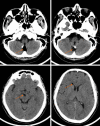Asymptomatic traumatic rupture of an intracranial dermoid cyst: A case report
- PMID: 34141765
- PMCID: PMC8180201
- DOI: 10.12998/wjcc.v9.i16.4046
Asymptomatic traumatic rupture of an intracranial dermoid cyst: A case report
Abstract
Background: Previous studies reported that most of the intracranial dermoid cyst ruptures were spontaneous, and only a few were traumatic, with asymptomatic much rarer than the symptomatic ruptures. Hence, how to deal with the asymptomatic traumatic rupture of intracranial dermoid cyst remains a challenge in the clinic.
Case summary: A 59-year-old man was accidentally diagnosed with intracranial dermoid cyst through a cranial computed tomography (CT) scan due to a car accident. A mixed-density lesion with fat and a calcified margin was observed in the midline of the posterior fossa, accompanied with lipid droplet drifts in brain sulci, fissures, cisterns, and ventricles. After 1 wk of conservative observation, no change was observed on the updated cranial CT scan. After 2 wk of conservative observation, magnetic resonance imaging examination confirmed that the lesion was a traumatic rupture of a posterior fossa dermoid cyst with lipid droplet drifts. As the patient exhibited no adverse symptoms throughout the 2 wk, a 6-mo follow-up visit was arranged for him instead of aggressive treatment. Nonetheless, the patient did not show any abnormal neurological symptoms in the 6 mo of follow-up visits.
Conclusion: Asymptomatic traumatic rupture of intracranial dermoid cyst could be just followed or treated conservatively rather than treated aggressively.
Keywords: Case report; Computed tomography; Intracranial dermoid cyst; Magnetic resonance imaging; Rupture; Traumatic.
©The Author(s) 2021. Published by Baishideng Publishing Group Inc. All rights reserved.
Conflict of interest statement
Conflict-of-interest statement: The authors declare that they have no conflict of interest to report.
Figures


References
Publication types
LinkOut - more resources
Full Text Sources
Research Materials

